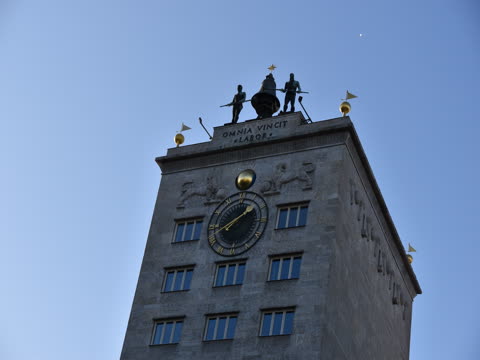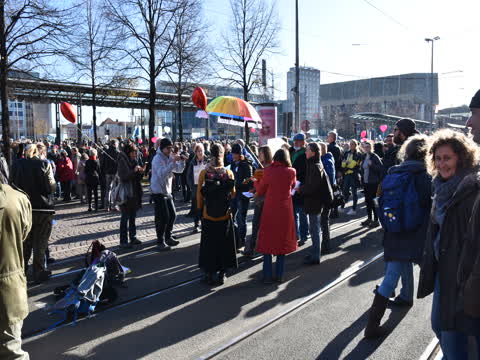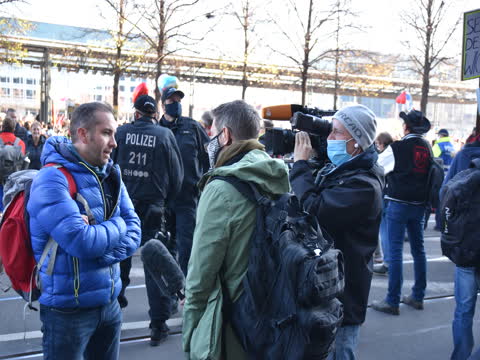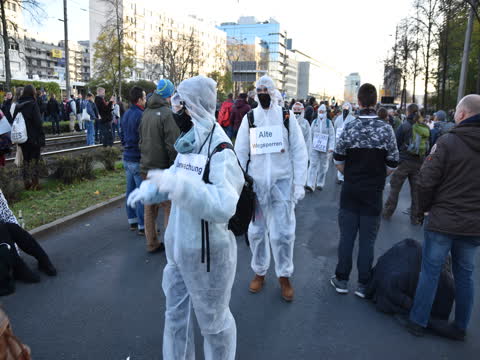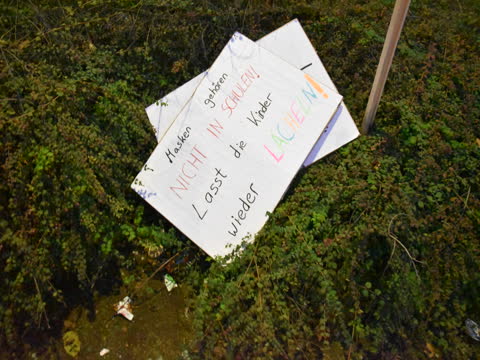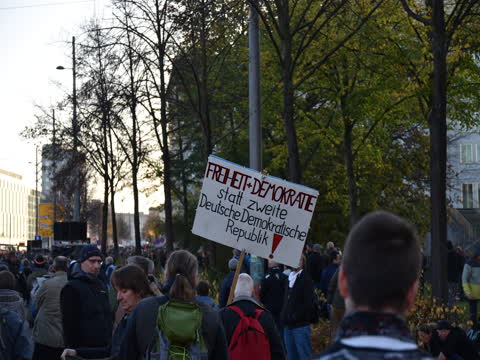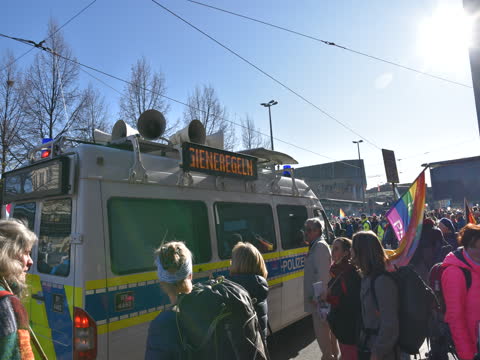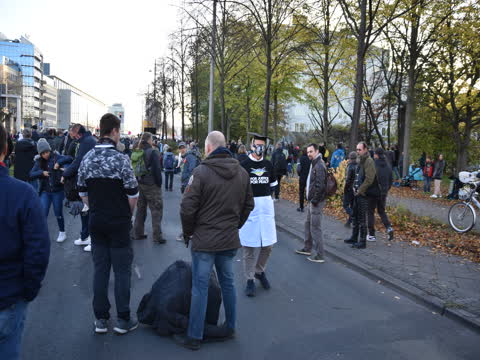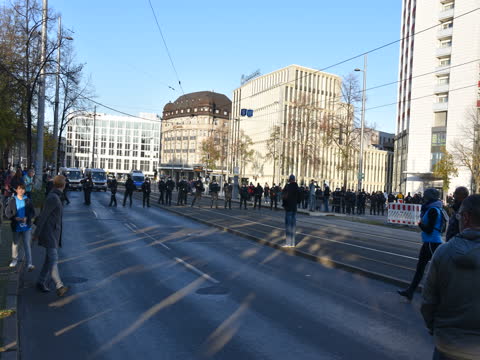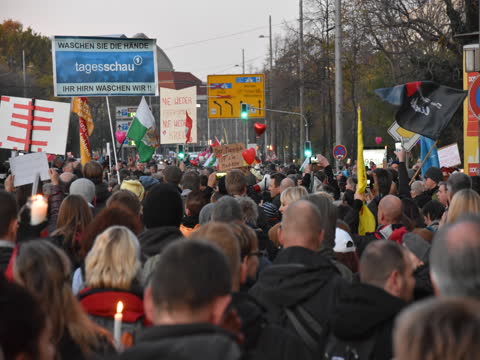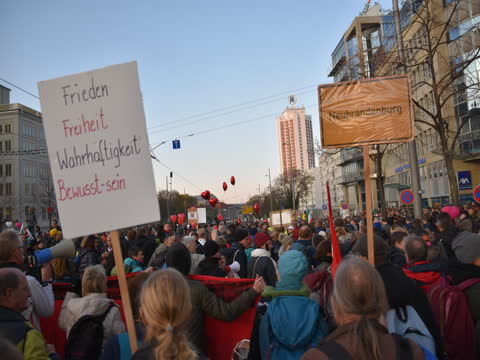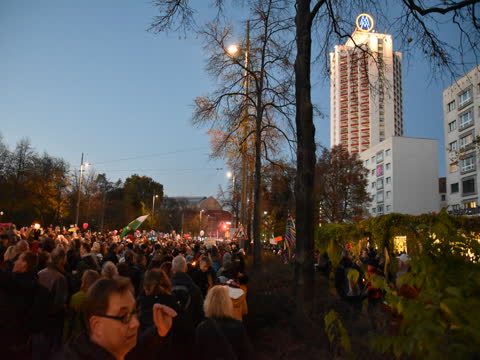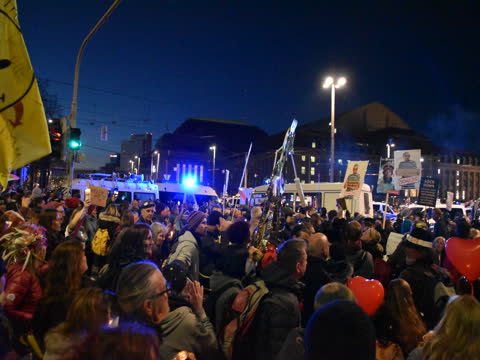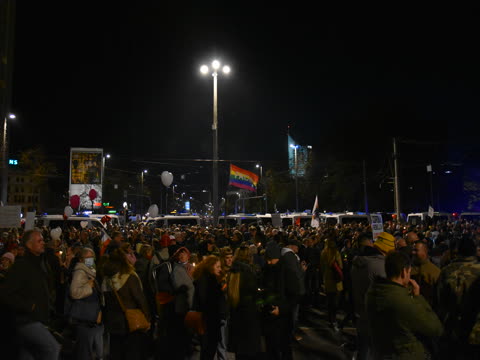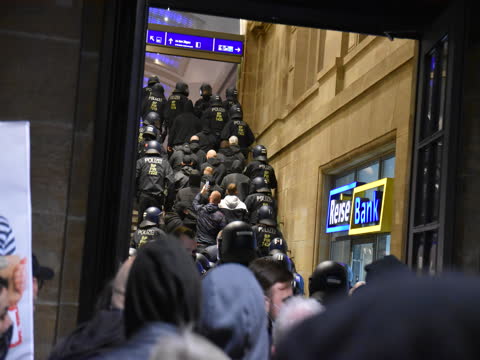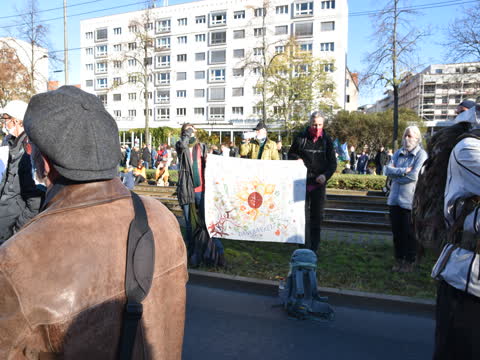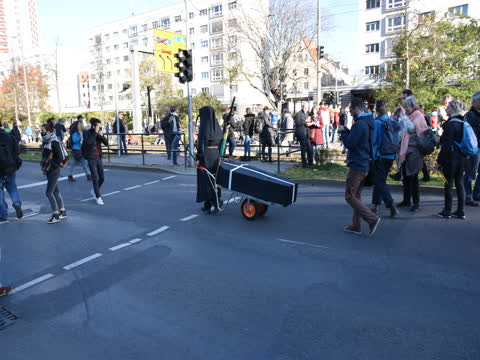UPDATE 2021-10-16
Almost a year passed since I wrote this post. Long time past.
There was a noteworthy statement by the head of police in Leipzig just after this demo (which I cannot recover on youtube, probably gone). He stated that it was not the duty of the police to apply force to largely peaceful demonstrants. And part of my initial judgement on the police was wrong.
Since the topic of this blog post was about the relation of scientific method and politics, I would like to share this recent article by John Ioannidis: “How the Pandemic Is Changing the Norms of Science” (Sept. 9th, 2021, tabletmag). It still makes me think a lot.
Yesterday, I went to a political demo in Leipzig. I would like to report my experience below, after reasoning whether this fits on my PhD blog.
An overview map of the area (from openstreetmap.org). The demo took place at Augustusplatz.

Should a scientist be influenced by political opinion?
Definitely not. Not in natural sciences and technics, not even in social or historical sciences.
As a scientist, I see my task in accumulating evidence. Not second hand evidence, but first hand evidence. And if I find ambiguous sources (as was the case for the Berlin demo in August), it is my duty to dig deeper. This is the reason why I see this as a contribution to my blog: as a PhD student, I force myself to put emotional arguments aside (as a first step, identifying my prior emotional bias), while attempting to accumulate evidence. I adjust my view based on evidence. This is scientific methodology.
During the first three years of my ongoing PhD, my perception of the mainstream media news has drastically changed. It was influenced by the way I learned to analyze and compare scientific articles. I try to dissect texts, separating the “true smell from the perfume”, extracting what is the relevant information and putting it into context. Article reading (better: working with literature) and news consumption must be hard work. Source checking, author checking, context checking are part of media competence. If one relies on “fact checkers”, one is lost.
I can encourage everyone to consume digital information in a more conscious way than is current habit for many consumers.
My standing goal in joining in and reporting about the “querdenken”-demo in Leipzig is NOT to express any political opinion on the covid situation. I just report (despite not being a journalist by training).
- My view on this event is just one particular perspective.
- There are many other perspectives, many of which contradict my viewpoint (I will show a media example at the end of this text).
- My view on the covid situation is my own and it is private, and be assured that it is more complex and ambivalent than I could present in the following text.
I herein provide one spatial and temporal sample of a complex situation. I was close, but naturally I only saw part of the events. For example, I left the scene at 18:00 o’clock, from amidst a peaceful gathering of a friendly group of people; I cannot judge on what happened afterwards. For example, I did not meet the counter demo.
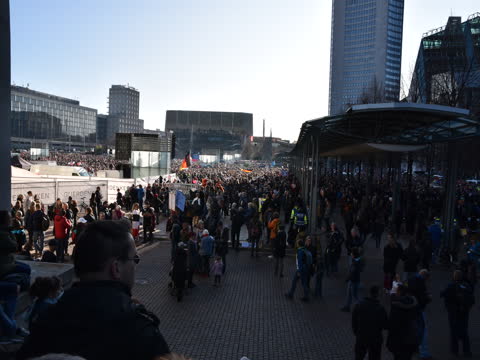
Main venue, overview from Goethestrasse.
I will leave it to you, my readers, to integrate this single perspective with the media coverage of the event.
Please do not (mis-)judge or condemn me or others simply for being there at the “querdenken” demo. If I have to summarize one thing about the event, it is that the audience was heterogeneous, and their motivations to be there were all but uniform.
Was the demo dominated by the (political) Right?
Many friends whom I told in advance that I would go to Leipzig claimed that “it’s the ‘Right’ who demonstrate there!” and argued I shouldn’t go. I understand the naïve judgement, because previous events (e.g. 29th of August in Berlin) were massively framed by media reports that indicated a right wing predominance. I had some secondary evidence that this is not the full story, and as you can read below, that was confirmed.
Yes, there were Right “activists”, or rather “passivists” I would say, because the ones I met were drunk already in the morning. On the regional train to Leipzig, where I was sitting and reading papers on animal locomotion, some supposed neo-nazis entered the train and surrounded me (peacefully). They looked like typical eastern German cliché-neonazis, some seemingly aged a bit since the nineties, just as one could describe them in a textbook. They were all male, 16-60 years, typical clothing, shaved heads, partially drunk, bragging about morning beers, calling each other gay, talking about social media accounts and their “experience” with women.
You might find them disgusting fellows. But actually they were rather harmless. We agreed that Belgian beer is good, and they wished me a pleasant day with the “lefties”.
I saw the exact same group again on the demo, standing with a few dozen more on the right side of the masses, waving two “Reichsflaggen” occasionally, but being socially distanced from the main crowd. Because I met some of them in the morning by coincidence, and I think I saw none of them back in the events which happened later the afternoon (see below), I think that particular group was not part of the “riots”.
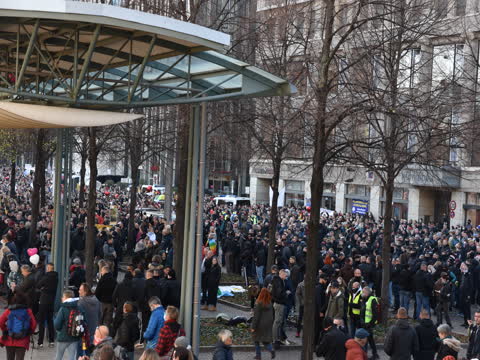
The Right wing (Goethestrasse).
Were members of politically right groups present? Obviously. So obvious that even ZDF (German television, notoriously blind on one eye) found them and used them as a non-representative background for a long interview.
Were those people dominating the event? Definitely not. They were rather free riders. And they were at least matched in numbers by the “Lefties” and antifa folks (who have an astonishingly similar fashion taste). Later more on them.
How do you tell a nazi from a non-nazi? How do you see that someone is from the political right? Just one anecdote on that: On my train home, two bald-shaved, athletic men of about 40 years clearly overheard discussions I had with other train passengers, nodding but not participating. When exiting in a village close to Magdeburg, one of them approached us saying:
“I wouldn’t mind all the shit they do to me. But it is a crime that they do all that to our children!”
Obviously, you can never tell motivation or political opinion from seeing a person. My judgement here and below depends on a lot of cliché, therefore has limited accuracy, which I fully acknowledge.
Was the demo dominated by Anti-Vaxxers and Alu-hat conspiracy theorists?
Same answer as above: those groups were present, but they did not dominate the event.
Also on the train to the event, I eavesdropped on a group of 5-8 healing practitioners (“Heilpraktiker”). Because they do not usually follow a “school medicine” training, some consider these practitioners’ qualification as inferior to that of medical doctors. According to that cliché, I heard them clearly disagree with the conventional virologists judgement of the pandemic. However, they discussed their own first hand experience on medical and political incidences in their surrounding. They had clearly spent a lot of time on handling the immediate consequences of the pandemic, and acquiring information about the disease. To me, they seemed by no means unqualified. In fact, they were extraordinarily well informed.
Later on the demo, I saw a lot of banners with anti-vaccine messages. I’ve overheard people talk about spiritual energy and I heard conspiracy theorists. I saw a few actual Alu-hats, but have a gut feeling that those were a satirical response to “covidiot” prejudice repeatedly expressed towards the present group. There were posters expressing speculative theses about Bill Gates and the WHO. The claim that masks are dangerous to health was omnipresent.
To me, there is nothing wrong about conspiracy theories. They are just hypotheses, and could in principle be turned over by evidence. Hypotheses that are not falsifiable (like those about Bill Gates) are simply worthless. Hypotheses that could, in theory, be rigorously tested under reasonable experimental conditions (like the dispute on the harms and benefits of masks) are a good stimulation for science.
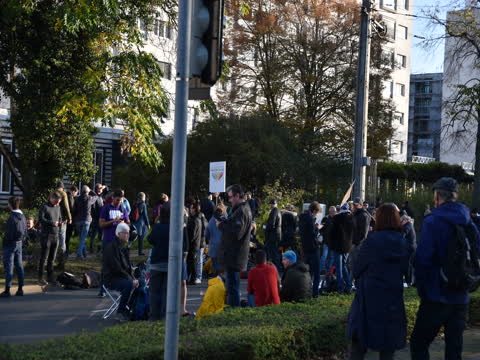
When did we last have "christians in resistance"?
I also saw little Q’s here and there. Christian groups. “Lehrer für Aufklärung”. German, Turkish, and American flags. And many others. But, as with the Rights, you cannot judge the masses by a few banners that stick out here and there. The crowd was heterogeneous. I find it rather a quality of the organizers’ philosophy that everyone is allowed and tolerated.
An artist came along, impersonating a huge, beautiful bird. She caught a lot of attention. As an alternative to attributing the event to political right or left, to conspiracy theorists, to ideologists, we could hypothesize that the Querdenken demo was instrumentalized by bird-humans.
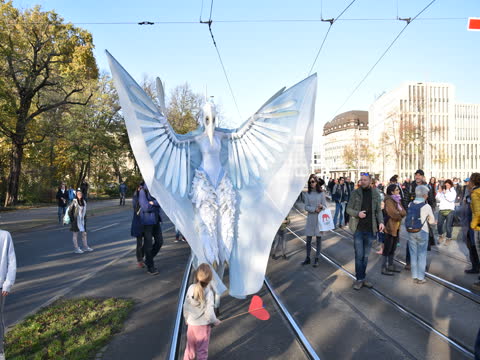
Birdwoman. The artist is Enaya Dateh, coratzel.de
What was the purpose of the event?
I have to re-emphasize that the group was heterogeneous. The organizers invited everyone to set a sign of peace. Yet, when the masses began to shout in unison, it were mostly the following words:
“Frieden! Freiheit! Demokratie!” (“Peace! Freedom! Democracy!”)
or: “Frieden! Freiheit! Keine Diktatur!” (“Peace! Freedom! No Dictatorship!”)
Few people hesitated to sing along. And the bannerless majority was clearly behind that slogan.
There was also, just a little less loud, the call for Merkel (German chancellor) and Spahn (German minister of health) to resign. To me, these observations are clear evidence that, besides being attractive for all kinds of ostracised groups of our society, the event was foremost political. The heterogeneous crowd was most likely an assembly of all those who are discontent with the political events of this year.
One may decide for oneself whether to agree or disagree with them. But at the least, one should listen. This “listening to people of a different opinion” is dangerously neglected in the publicly visible political discourse. [I have a hard time writing “discourse”, because politicians, workers unions, talk shows, I perceive all these supposedly spicy ingredients as streamlined; there’s not even salt in the soup.] The organizers of the events in Leipzig, and their team of lawyers, did a great job in giving people a platform and trying to make their relevant voices heard.
Did people disobey hygiene rules?
In my opinion, this is not a relevant question. One putative “consensus” of people who came to the demo (maybe even a majority) is that the politically imposed rules of wearing face masks and keeping 1.5 meters distance are (a) a measure of oppression or (b) dangerous to our psyche and health or (c) simply irrelevant. [You see, I guess that this is no actual consensus, but that opposing the masks is rather a minimum, commonly agreeable goal.]
A more relevant question might be, “could anyone who demanded that safety at the demo get it?” I must say: yes. In other words: Was anyone forced to hug or take a mask off? Unlikely. I did not observe people being forcefully pressed into a space of less than the generally perceived safe distance. I personally wore a mask almost all the time and was never asked to take off that “symbol of opression”. Yes, people got closer than 1.5m to me, especially when we set to march in circles when the police did not let the crowd out via the planned route (see below). However, at no time did I feel that I could not have stepped out of the crowd. Compared to rock concerts I’ve seen a couple of years ago, it was comfortably spacious at all times.
But was the space sufficient to avoid corona virus contagion?
You may argue that my opinion on the relevance of the “hygiene rule question” is misled. We have a pandemic, after all, and you may give that priority. You may argue that there is an epidemiological necessity for people to follow the distance and mask rules at all times. I agree to some extent. But maybe that is no valid reason to condemn the demo, where people are of another opinion.
Hence, please bear with me, nevertheless. Assume for now that there were 20000 people on presumably sufficient space (as long as the demo went the organized way). Assume the space that was available was well used, although there were inappropriate local clusters.
One point of evidence justifying this assumption: the main stage rallye was temporarily interrupted at around 14.30 o’clock, and the organizers asked people to spread to the side streets. Most people followed, side streets were filled, and only then the event continued. Though I could not oversee the main venue from my side street, I would argue that the space which was given to the crowd by the police was sufficient. As far as I could oversee from a bit away, people did spread well and obeyed the dispersion orders quickly.
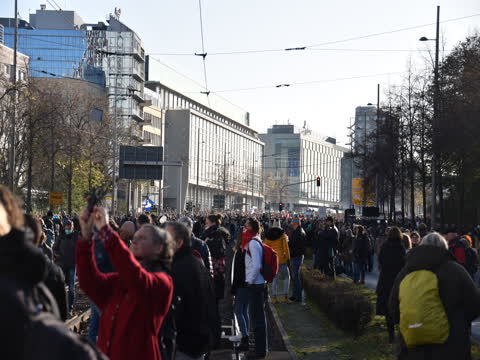
Georgiring, looking south towards the main event.
However, there is a big BUT. And that “but” was the police strategy. This requires me to describe the afternoon events in a bit more detail.
What was the role of the police?
First and foremost, I want to send kudos to all the police officers who stood “at the front” in the event. They doubtlessly had a hard day, but fulfilled their duty well. It must be annoying to have the crowd persistently shout “Schließt Euch An!” (“Join Us!”) whenever you pass by with a few colleagues. But the policewomen and policemen stood bravely. The purpose of the police on such an event is to protect the participants and give some guideline. For example, this involves separating counter-demos. As with previous events, I think the police administration worked together closely with the event organizers, and apart from that they apparently executed their internal orders well.
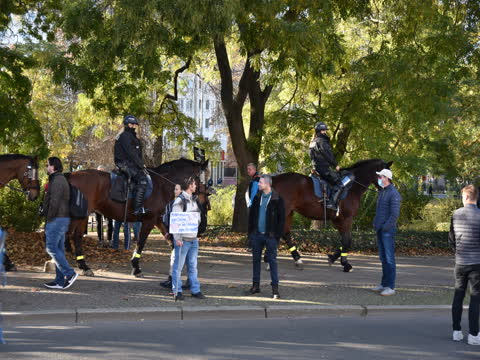
Sign says: "Masks protect against covid as underwear against diarrhea."
But, as far as I can tell, police administration and political stakeholders also played their tactics.
- For example, it was announced the evening before, publicly and seemingly official on regional media, that the event was moved to a parking space at “Leipzig Messe”. That was clearly not true, which I luckily saw when passing there with the train. I heard, but cannot confirm, that video and audio equipment on Georgiring and Goethestrasse (used for remote viewing of the main stage) had been removed because of the pending relocation.
- For example, administration let the tram traffic run on those adjacent roads (which were part of the agreed demo space) for much too long. The organizers claimed that this was against prior agreement, and of course it limited the space for people to spread and follow the rules. Tram service was only finally stopped just before 13.00 o’clock, when the main event began and too many people were on the main venue. They could have spread before, if it were not for the trams. When asked to, demo participants immediately dispersed to the extra space.
- For example, why did the police let too many people enter? Media report police complaints about too many participants, estimated 20000, when there were just about 16000 admitted. Wouldn’t it have been reasonable to plan a safety buffer? Would it not have been a police responsibility to organize, redirect, or if necessary prohibit access for further participants, as is customary with football events?
Then, on the side road where I was situated later on (Georgiring, towards main station), policeman suddenly installed a full blockade of the road (15.00 o’clock).
This was the direction in which the demo march was supposed to lead. One of us went to ask the officers what was supposed to happen, and he replied that there was no reason to worry if we just wore a face mask and kept distance. Then at 15.30 o’clock, the police gave signal to the organizers to end the event and dissolve. After about 10min argument with the lawyers, the organizers informed the masses that the event was terminated by the police (which they the organizers’ lawyers consider unlawful). They asked everyone to act reasonable and stay peaceful, and just stopped the main event. To keep themselves from legal harm, they were forced to stop their organizational responsibilities.
And so the event stopped.
People just… went away?
Not exactly.
People were obviously disappointed. However, as far as I could see, not many people decided to leave via the way to main station (I overheard but cannot confirm that in some other direction, people were advised not to leave, apparently because there was a counter-demonstration). The sudden end was anticipated, and what I could oversee remained peaceful.
So the remainder of people set afoot and lit the candles they were supposed to have brought. All was peaceful and civilized.
And because the police did not allow the crowd to go round the “Ring” street, as was originally scheduled for 16.00 o’clock, people started to go in circles. So there we were, 20000 or less people with candles moving in circles on a too confined space next to Augustusplatz. At that time, hygiene distance was indeed hard to maintain, but that was just after police had interfered with the organized part of the event. Was that a wise decision? Hard to tell. I guess the police has more evidence now.
With people going in a circle on the square, some megaphone people announced that police was confused and did not know how to react (which is a hypothesis, not too plausible).
Interestingly, when my local sample of the spatially periodic mass movement passed the street to main station a second time after about fifteen minutes, there was a group of black-clothed, (predominantly young male) people opposing the police barricade. Those rioters had appeared rather suddenly. The main crowd movement made a turn about ten meters before reaching them. The black-clothed block was clearly not part of the main movement. Also, as mentioned above, I did not recognize any of the putative neonazi group I had met on the train.

Sudden appearance of black-fashioned people.
From what I heard, you can parallel this incidence to the events in Berlin on a recent demo (just search “Reichstag b2908”).
Shortly after, we heard exactly one loud firecracker burst. And I briefly saw three pyrotechnic products (like signal pistols or bengalos; white/red flame, but burning down rather unspectacularly) being fired/thrown on that road to main station. But the mass of the crowd could not see what was really going on, and from 500 meters away I heard and saw little evidence of a severe battle.
Immediately afterwards, the crowd slowly passed onwards, downhill.
Further down the road, where the main station road police barricade was earlier, stood a small island of police cars and officers surrounded by peaceful folks.
Everyone just went on to demonstrate peacefully. Some of the “rioters” stood on a little bus stop roof waving a Swedish flag.
A Samba drum group was doing a fantastic job. Everyone was happy that we could peacefully proceed. There was nothing that remotely resembled a “battle” or hooligan cockfight.
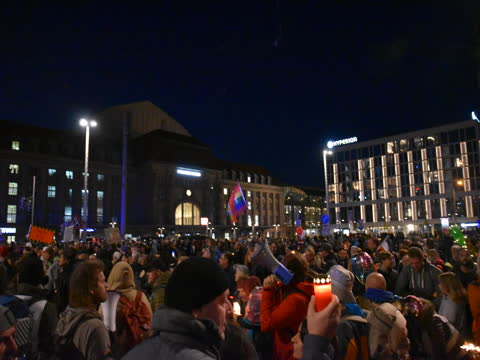
Arriving at Leipzig Hauptbahnhof.
I suppose the police made way without much resistance, but since I was not at the front, this is no first hand conclusion.
I joined a spontaneous choir of “Die Gedanken Sind Frei” and other folk songs. Realizing this could not be topped, I decided to make my way into the station and leave, one hour before the official end of the original demo. Just when I was about to enter the station, a group of about a dozen black-clothed young men was led through main station by twice the number of police officers. They advanced rather quickly, shouting paroles and taking photos with their smartphones. That was probably the weirdest scene I saw yesterday.
Just when my train was about to leave, police officers (of whom there were plenty in main station, who could have easily come out to support the islanders) entered the train and impolitely insisted that everyone should put their facemasks on. I perceived this as unnecessary bullying, and a young mother-of-three commented that it was a shameful waste of tax money.
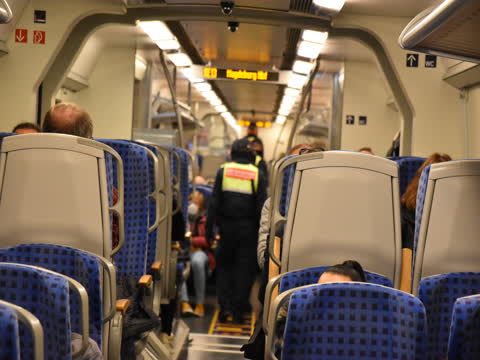
Train home (almost ready to leave).
I would, from my limited perspective, judge decisions by the police administration as questionable. It seemed to me that some of the decisions kindled riots rather than de-escalating the situation, whereas it would be police responsibility to guide the peaceful demo towards a good end. I must say that I was unable to observe the situation at the counter-demo (but see media coverage below). And if indeed the police retreated without resistance, and justifies the ending of the main event, then I am willing to overthink my judgement.
What else happened?
There are more anecdotes I could tell (mostly irrelevant, please don’t ask me about non-functional train toilets). There was music, but too little for my hippy taste. We had an interesting, long discussion with a young Chechen Muslim. I met a lot of people who seemed glad to have a place to talk about their unconventional opinion on the covid situation; it seemed like a good day for spiritual care and chattering.
Many people I met seemed troubled in one or the other way by covid, and in particular the political response to the crisis. On the train, I had beautiful discussions with both disillusioned young people (unable to raise arguments for their point; clearly terrified and overstrained by the ongoing pandemic) and those whom they would call “covidiots” (in fact rather well-read best-agers, but equally overstrained and overwelmed by the alternative media information). There were also young people defending their point validly, and excellently demonstrating their ability to disagree, with arguments and mutual respect.
I can recommend to everyone to go to corona events, even if you prefer to stand beside the crowd, and discuss. Astonishingly many of the participants are open for discussion, and many (not all) can be reached by science-like discourse and accounts of evidence.
Was the demo legitimate?
Peace. Freedom. Democracy.
In my opinion, those are valid basic rights, and I understand why people see them threatened. Our political system should be able to embrace open discussion. On the background of the severe epidemiological situation, this particular event was thoroughly organized. Accordingly, it had been approved a priori and confirmed by courts, although there appeared to be political tricks trying to force trouble upon the organizers.
update 09/11/2020 The court confirmation (Oberverwaltungsgericht Bautzen, AZ “6 B 368/20”) is a strong sign.
I heard Holger Mann, the head of German “Social” “Democrats” Leipzig, on the radio the morning after this post. He expressed a rather “outside the box” understanding of law, speculating that the court decision was shortsighted or even ideologically biased.
This is highly dangerous.
In my understanding, our legal system is independent and has to judge events or decisions on the background of current law.
If such a high court concludes that the demo is in agreement with law, then one should have good reasons to doubt.
“Having been terrified at the demo” is no such reason, even if I would share that experience reported by the politician.
I interpret the statement by Mann as an attempt to direct the public indignation towards the courts, whereas it should be fully devoted to the politicians.
In contrast to the court decision, many news read as if the demonstration was not legitimate, and demonize participants by re-iterating the potential threat to public health or to public political opinion. Here is one example of media coverage, by “Redaktionsnetzwerk Deutschland” (RND), who don’t even have shortlinks: https://www.rnd.de/politik/querdenken-demo-in-leipzig-veranstaltung-endet-im-chaos-auch-attila-hildmann-soll-vor-ort-sein-kritik-an-sachsens-innenminister-BW7WL3TL7ATKTF5BMMDAQKWKJU.html
And then, the next day, Politicians get the chance to pretend to be scandalized. Or maybe they are. Why do the media give a platform for their ridiculous race for attention? For example, does anyone seriously find it relevant that the Minister of Interior Affairs praises the work of the police? It would have been news if he hadn’t.
I checked multiple other sources, and the reports in the main stream media are rather uniform. The RND article linked above claims in the abstract that there were nazi chants from the masses. As I reported above, I cannot confirm that, not even in tendency, for the main crowd, while I was there. The article links the peaceful protests to Attila Hildman, who doesn’t have anything to do with the movement; he is a completely irrelevant person. RND report the demo ended in Chaos, but that can be considered an intended result of the strategy of the police administration (which we must assume to be experienced and well-organized).
As a participant, I find the media coverage of the demo inaccurate and misleading. Many reports intentionally attempt to give the impression that the whole event was dominated by a small group of unpleasant people (who were in my impression unwelcome by-standers, at best tolerated by the tolerant majority). Would it be legitimate if the organizers had excluded (groups of) people from participation?
A different perspective, which I did not have on my radar, was displayed in a report from RT deutsch. I recommend to watch that report. The contrasts between the main demo and the counter-demo are noteworthy, and presented neutrally. I chuckled when the young lad talked about social media bots to the physically present reporter, and wish him good luck with his homework.
update 09/11/2020 Did you realize when you read above that I did not recognize the neonazis on the “battlefield”, that that was just a “fog bomb”? Even the author realized that just after posting the article. Me, as a single person, I could hardly have recognized a group of people whom I only met briefly in that crowd situation. Or the ones I saw before were elsewhere. Did you eat what I wrote? The recognition is not relevant. I (consciously or not) tried to downplay and frame the observed events. The essence is that the Right block were bystanders, both on the main demo, and later for the uncoordinated part of the meeting. I tried to provide sufficient evidence, in the form of full resolution, unmodified photos. Of course, I am subject to confirmation bias, and that influences my writing and photo selection. Maybe you find further evidence!
Do you consume media consciously?
To summarize my overview on media coverage: there are neutral reports about the event. But curiously, those are to be found on the broadcasters that are considered “sources of disinformation” by many.
Summary
I note a general tendency to frame so-called “anti-corona”-meetings (whatever that means and whatever they actually are) as “politically right” and “conspiracy” and so forth. According to my experience, this false narrative is used to de-legitimate peaceful political protest.
In contrast, I personally experienced the Leipzig event as a political demo of a non-parliamentary opposition to recent political decisions. It is an opposition movement that is currently not reflected by any of the major political parties in Germany, maybe because it is heterogeneous, but unified by a feeling that something is going wrong. Such opposition must be tolerable in a democracy that has pluralism of opinion at its foundation. It must be tolerable even in the current situation. It does not matter whether one agrees or disagrees with the opinions that are presented, we as a society must tolerate other opinions, discuss them, listen. If deviating opinions are considered dangerous, then politicians must deliver convincing arguments (evidence!) why there is danger, and give people a perspective. Delivering arguments should be easy in the covid situation. A perspective might be harder. But that’s their job.
I can only recommend to everyone to join political events like the one described herein. At least once. To participate, observe, or even disagree. And I recommend to acquire and share first hand evidence, rather than blindly believing suspiciously one-sided reports.
Thank you for reading! Stay open-minded. Stay safe. And all the best,
Falk
P.S.: I appreciate comments and feedback, also of critical nature, via “contact”, and will post them below if you signal consent.
“Fear is the path to the dark side. Fear leads to anger. Anger leads to hate. Hate leads to suffering."
Master Yoda, "Star Wars: The Phantom Menace"


